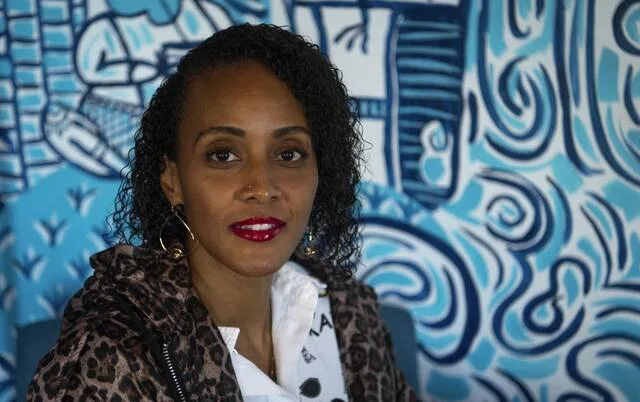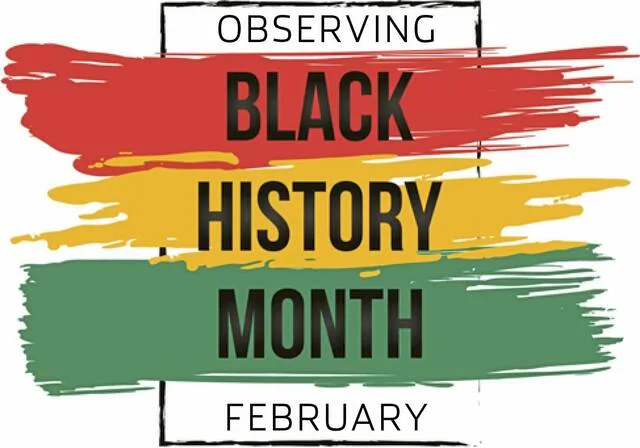Jasmine Green sat in the kitchen one afternoon in 2003, getting her hair done by her grandmother.
Her curly coils were being parted in sections with a slender comb to reveal her scalp. Vaseline was placed on open areas between the parts. After the Vaseline, a thick, pungent white cream was layered on the roots.
The smell permeated her nose.
The cream went on cool. With each minute that passed, an intense burning sensation grew. She squeezed her legs together to combat the pain. The longer she could endure, the straighter her hair would become.
Finally, after about 20 minutes, just as she could not take it any longer, the thick white cream was rinsed. When she came up from the water, her hair was completely straight.
The Monroeville native’s memory of her first hair relaxer treatment, when she was in the third grade, is still vivid.
For Green, director of education at 1Hood Media, a local broadcasting and media production company, getting a relaxer was a coming-of-age thing, and she did it for eight years. It was something her mom, sisters and grandmother did.
Her story is reflective of many Black women’s experiences when it comes to hair care.
Now, with new evidence showing a correlation between chemical hair straighteners or relaxers and increased incidents of reproductive cancers, there is a push to understand and conduct more research on relaxers’ impact on Black women’s health.
In October 2022, a study conducted by the National Institute of Environmental Health Sciences was published. Called The Sister Study, it was a decadeslong project that initially analyzed environmental and genetic causes of breast cancer. An offshoot of that study found that its participants who used straighteners were mostly African American or Black women, and there was “evidence of association between the use of straightening chemical products and uterine cancer.”
More than 2,000 women have joined a federal lawsuit and other class-action lawsuits suing major cosmetic brands. The lawsuits allege negative health implications because of the formulation of chemical hair straighteners or relaxers with endocrine-disrupting ingredients.
The study was not designed to look at uterine cancer risk. It was meant to take a closer look at high-risk populations and genetic and environmental risks for developing breast cancer. The women who participated were chosen based on having a first-degree relative with breast cancer; none of the women in the study had breast cancer going into it.
Though it was a large study, only 7.4% of the participants identified as African American or Black. As part of the questioning about environmental factors, a link between using hair straighteners at least four times a year and the development of uterine cancer was found, according to Amanda Hercules-Smith, an internal medicine physician at St. Clair Health and medical director of St. Clair Urgent Care.
Hercules-Smith said uterine cancer accounts for 3% of all cancers in the U.S. — about 66,000 cases per year.
“For the women who never used chemical hair straighteners, their risk was 1.64%,” she said. “And for those that did, the Black women, their risk (more than) doubled to 4.05%.”
There was almost a double risk of developing uterine cancer.
“Black women in general have a higher risk of developing uterine cancer, and that is based on multiple factors, but, in addition, women who used hair straighteners double their risk,” Hercules-Smith said.
Hercules-Smith said it would be inaccurate to say that chemical hair straighteners or relaxers directly cause cancer, but the frequency of use may play a role. She said the study has opened a gateway for more research to be done on chemical straighteners and other environmental factors that affect Black women.
“The study thus far is not enough to make the recommendation that Black women should not use relaxers, but I would say decrease use overall … being aware if you have a family history of breast cancer or uterine cancer, consider your choices always,” Hercules-Smith said.
Tamiah Bridgett-Alexander, a Garfield cosmetology educator specializing in natural hair, had her uterus removed by age 39. She estimates she had more than 100 relaxers during the 10 years she chemically straightened her hair, beginning at age 12.
“I am a woman who has lost her uterus, and I can’t say for sure that it wasn’t because of relaxer use,” she said.
Uterine fibroids run in her family, she said. “What I’m noticing is that in spite of the evidence, at one point, there were a lot of women going natural. But as most things that are trendy, it is cyclical, and what I am noticing now is that there are women who are even returning back to relaxer use, despite the statistics that are made available to us.
“You don’t know the impact of any of it. For me, it’s very clear it’s not safe to have relaxer use over a long period of time.”
Cognitive dissonance and the impact on the mind
There is a cognitive dissonance, Bridgett-Alexander said.
“Our psyches have been affected by feeling like we need to have straight hair to feel beautiful and be accepted,” she said.
Bridgett-Alexander does extensive work through her company and the community she created in 2010, “It’s a Natural Thang,” trying to get Black women to embrace their natural hair and learn how to care for it. She hosts one-on-one classes, has organized a Facebook group and has educational events and meetups.
The catalyst for Bridgett-Alexander going natural “was not accepting the messages of anti-Blackness that I’ve been given,” she said.
Similar to Green, Bridgett-Alexander got her first relaxer on the brink of her teen years. She was 12, the same year she began puberty and started getting her menstrual period. She had relaxers every six weeks until she was 22.
“I noticed my first uterine fibroid at about 21 or 22, and I had my first surgery to remove them when I was 29. By the time I was 39, I lost my uterus,” Bridgett-Alexander said. “I can’t say if it was exposure, but it is not something that I would recommend for people. What I want is overall health for people who choose to have natural hair. For Black folks, we struggle so much with our hair, and just to come into peace with it is the ultimate health.”
Bridgett-Alexander was an inspiration for Green when Green decided to stop relaxing her hair. Green desired to break free from the pain-centric beauty ritual and wanted to discover herself and embrace her Blackness.
“One of the things that I remember the most, unfortunately, is the acid burns that would leave thick scars on my scalp,” Green said. “I just remember running my fingers through my hair after a fresh relaxer (perm) and feeling the scabs forming. And that was from the acid being on my head if I scratched within 24 to 48 hours ahead of getting a perm. I would get reminders from my parents, ‘Oh, that’s why we told you not to scratch because it is going to open your scalp up to the acid.’ ”
A perm is a chemical process of permanently or semi-permanently altering hair texture. There are curly perms to allow straight hair to gain a curl pattern or wave. The straight perm, synonymous with the word relaxer, alters the molecular structure of hair, making curly, coiled or wavy hair straight.
Around 2012 when Green went natural, the transition was not easy — she attended a high school where the beauty of Blackness was not positively reinforced, and in her senior year she was one of two people with natural hair. Green, now almost 15 years natural, could never think of returning to relaxers.
“Pain shouldn’t be at the heart of my beauty experience, and I didn’t have to align with the mainstream beauty standard,” she said.
That was extremely freeing.
Beauty is not pain
“Good Hair,” a documentary by Chris Rock exploring the focus on hair in Black culture, allowed Green to see other Black women’s natural hair journeys, and it influenced her journey.
But the opposite of “good hair” is “bad hair,” Green said. “We’ve all been told our whole lives that our natural hair is ‘bad.’ ”
Christel N. Temple, a professor of Africana Studies at the University of Pittsburgh, said “bad hair” is a term that needs to be erased.
According to Temple, what possibly led to the pervasiveness of relaxers among Black women is some of the loss of hair care techniques due to enslavement, although the one that remained was braiding. Additionally, popular culture aesthetics, what’s in style and relaxers create a sense of well-being and ease.
“When I grew up, my mother wouldn’t let us wear ponytails,” she said. “Wearing a ponytail based on the ’80s culture meant that your hair wasn’t done.”
Temple considers the creation of chemical relaxers the health measure of well-being.
“Like, do I look good, do I feel good when I walk out the door? Am I having a good hair day?” she said. “We’ve been learning that there are carcinogens and toxic chemicals in the relaxers. That is striking but not surprising in terms of health disparities.”
Women — and Black women in particular — have received less funding, less interest and less follow-through in scientific studies that test the safety of the products related to them.
“This just adds another level to the disparity — that the chemical relaxers that gave us a psychological well-being are now bad for us,” Temple said.
She said a lot of choices that Black women make related to beauty is rooted in U.S. culture, social mores and what a person feels is aesthetically pleasing.
“But we cannot give white people the credit for everything that we are trying to do, like we as in Black people are trying to be like them,” Temple said. “It can make us feel so silly. I went 20 years getting relaxer. You know it might burn when it’s on too long. I didn’t know it was unhealthy.”
A level of accountability by the companies that sold the products would be satisfying, Temple said.
“They owe Black women for the years of deception,” she said.
Years of deception and what to do next
In 1909, Garrett Morgan, an African-American inventor and businessman, invented the perm in Cleveland. Morgan also was the inventor of the three-way traffic light. The invention of the chemical hair straightener was an accident. He was using a liquid that caused sewing machines to work more efficiently, and the liquid got on a textured piece of fabric. When he returned the next day to work at the sewing machine shop, the fabric was soft.
When he found the formulation, he tested it on his own hair, which altered the structure. Morgan created his own hair care line, which includes G.A. Morgan’s Hair Refining Cream, sold for $1 with the original tagline “Straighten hair in 15 minutes.” Today, relaxers can be bought for at-home use between $5.88 and $70. A salon visit to receive a relaxer can be more than $100.
The original ingredients are sodium hydroxide, which breaks down the hair bonds, and guanidine carbonate. Prior to Morgan’s invention, the hot comb — a metal comb that could be heated in an oven or inside a heating device — used to straighten hair directly from the root. While the comb was and still is used to straighten hair, it is easy to accidentally burn the skin.
The relaxer was further popularized in 1919 by a larger brand called Proline and gained widespread popularity by the 1990s. It was widely used by Black women until the natural hair movement took off in the mid-2000s.
Since their inception, formaldehyde, or methanediol, is a common ingredient in hair relaxers. A possible ban on the ingredient in chemical hair straighteners by the Food and Drug Administration could go into effect by April, according to the U.S. Department of Health and Human Services.
According to Hercules-Smith, formaldehyde enters the body through inhalation and skin absorption. For women who feel they may have been impacted, some symptoms to be aware of are abnormal vaginal bleeding, pelvic pain, lower back pain and abdominal bloating, Hercules-Smith said.
Women can request a pelvic ultrasound from a primary care provider or gynecologist, Hercules-Smith said.
The beauty of Black hair and the immense versatility
Deaja Vire, a freelance cosmetologist and hairstylist based in East Liberty and Shadyside, used to relax her hair about once a year, but as she learned more about the health impacts, it’s something she no longer does.
“I think many people don’t realize how important it is to protect yourself from chemicals,” Vire said. “If a chemical is taking your hair from curly to straight, that is an alteration to the integrity of your hair.”
Vire said she tries to steer clients away from relaxers. But she also tells them it is their choice. If they choose to relax their hair, she will honor it.
“With our natural hair, we were told it’s nappy, it’s kinky, the comb is breaking — and it’s left this trauma,” she said.
Those traumas can lead to the degradation of self, according to Vire, “as a woman, as a Black woman, as a person.”
Most of her clients now are natural.
The beauty of Black hair is there are so many options beyond the use of relaxers, silk presses to locs and everything in between. For healthy hair care, Vire recommends consistency, deep conditioning and using raw butters or raw oils such as shea butter or mango butter.
A silk press manipulates natural hair without the use of chemicals, using a blow dryer to straighten the hair and then a ceramic-plated flat iron to smooth and straighten the hair further. Occasionally, plastic wrap is used around the head to ensure a smoothness, longevity of the style and that moisture is retained. The style can be maintained for weeks by wrapping the hair nightly with a silk or satin scarf.
Locs are strands of hair that have been coiled together or rolled together by hand. They create a rope-like appearance and trace back to Ethiopia, representing devotion, purity and spirituality.
Right now, Vire touts Mielle Organics as a go-to product line. She also recommends getting daily nutrients, vitamins and water. For others who may want more information beyond the salon, Vire recommends seeing a trichologist, or someone who can analyze the health of the scalp.
Though Green is now natural and finds power in donning her natural hairstyles, she is concerned about the possible reproductive health impact. The conversation, in her mind, goes back to environmental racism in which certain toxic chemicals are allowed to be consumed or permitted within close vicinity of Black communities.
“There was a backlash to people embracing their natural hair textures: Can you be in a high professional space and have these hairstyles. Can you be in a learning environment?” she said, citing a teenager in Texas who is fighting a school suspension case.
Only recently was the CROWN Act adopted by Pennsylvania — CROWN stands for Creating a Respectful and Open World for Natural Hair. The law prohibits race-based hair discrimination. This means people may not be denied employment or educational opportunities based on their hair texture or how it is styled.
“So you are seeing all of this pushback for people embracing their natural hair texture, but on the other side of this are chemicals that are killing us,” Green said. “It is deeply aggravating that we are not allowed to have any sort of autonomy over how to best take care of ourselves.”
Green doesn’t know what the solution is, especially as some women are still using these products.
“I am hoping that as more research is done, there are possible ways to mitigate it,” she said. “Just because they are using these products does not mean that their health should be at risk.”
Shaylah Brown is a TribLive reporter covering art, culture and communities of color. A New Jersey native, she joined the Trib in 2023. When she’s not working, Shaylah dives into the worlds of art, wellness and the latest romance novels. She can be reached at sbrown@triblive.com.
Categories:
Allegheny | Black History Month | Health | Lifestyles | Pittsburgh | Top Stories






